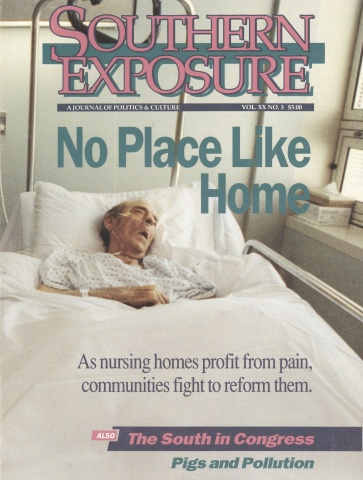The Bible Belt

This article originally appeared in Southern Exposure Vol. 20 No. 3, "No Place Like Home." Find more from that issue here.
From small whitewashed churches to massive televangelism halls, organized religion represents a stronger force in the South than anywhere else. Sometimes a defender of the status quo, at others an advocate for social change, the church continues to play a leading role in dividing the South along racial lines and in shaping Southern culture and politics.
A staggering 56 percent of all church members in the nation today are Southern Baptists, and 40 percent of all churches are in the South. Texas has more churches than any other state, with North Carolina a close second.
According to a Gallup poll, 63 percent of Southerners consider religion “very important” in their lives, compared to 54 percent in the Midwest, 48 percent in the West, and 45 percent in the East. Nearly half of all Southerners consider themselves “born-again” or evangelical Christians, compared to less than a third in other regions.
Religious beliefs have always spanned a wide spectrum in the South, from the earth-centered spirituality of Native Americans to the Anglican Church in Jamestown, Protestant sects like the Shakers and Moravians, and African traditions brought over by blacks sold into slavery. “The church in the South is about 99 different things,” says Jim Sessions, executive coordinator of the Commission on Religion in Appalachia.
Perhaps the strongest force shaping religious life in the region was slavery. Under the plantation system, black and white Southerners developed strong Christian churches to address the needs of their congregations — but their spiritual beliefs and political agendas differed sharply.
“The slave master was praying for his wealth to increase, and his wealth was embodied in the slave,” says C. Eric Lincoln, professor of religion and culture at Duke University. “The slave, worshiping the same god, was praying for his freedom and release.”
The distinctions became sharper in the early 20th century, as opposition to the teaching of evolution fueled the spread of white fundamentalism. Preachers like J. Frank Norris in Texas and Bob Jones in South Carolina popularized fundamentalism during the Depression, and Oral Roberts and Billy Graham raised evangelism to a new level of mass appeal — and money-making potential —with televised revivals during the 1950s.
Today fundamentalism is promoted by schools like Liberty University in Lynchburg, Virginia. “You could say that Liberty is one of the notches on the old Bible Belt,” says Dr. Elmer Towns, dean of the School of Religion. “We still hold to certain pro-family values that we think came right out of scripture.” University graduates, says Towns, play influential public roles. “We have people working in the White House for the President.”
While the black church has developed its own brand of fundamentalism, many black congregations have fostered spiritual beliefs emphasizing social change. “The church as a whole has been all too negligent on the question of civil rights,” wrote Reverend Martin Luther King Jr. “It has too often blessed a status quo that needed to be blasted, and reassured a social order that needed to be reformed.”
The black church was often at the center of the fight for voting rights and desegregation that emerged in the 1950s. Black ministers and divinity students rallied at the state house as well as at the church, making civil rights a political and a moral issue.
“The church was the one place that we could go where we really felt we were affirmed,” recalls Isaiah Madison, a Methodist minister and executive director of the Institute for Southern Studies. “It was the way that people organized and educated themselves — both to better themselves and to correct injustices in society.”
Many poor whites have also founded churches independent of the religious establishment. Coal miners in small mountain towns, for example, often rejected the “company church” and started their own. Even today, small churches sign newspaper ads in support of striking miners.
To encourage interracial cooperation, some black and white churches are building bridges between their congregations. Biracial “partnerships” have formed in Tennessee, Texas, and North Carolina, bringing blacks and whites together so they can get to know each other.
“We have done a lot of laughing, a little crying, and a lot of praying,” says Dr. David Forbes, a minister involved in a bi-racial partnership in Raleigh. “And, we believe, some overcoming.”
Tags
Mary Lee Kerr
Mary Lee Kerr is a freelance writer and editor who lives in Chapel Hill, NC. (2000)
Mary Lee Kerr writes “Still the South” from Carrboro, North Carolina. (1999)